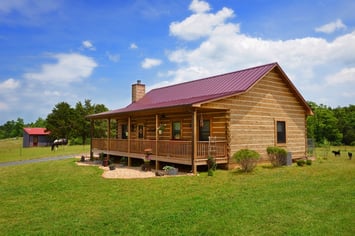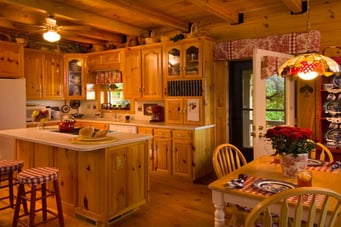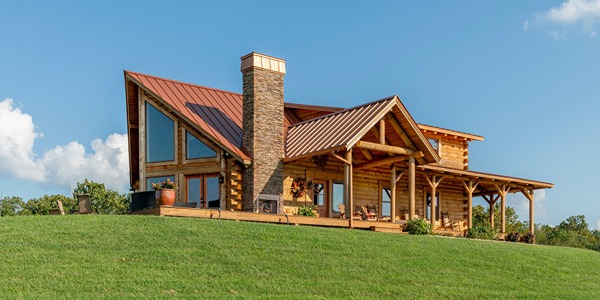No matter what your budget is when building a home, it’s always nice to save a little money. Although plenty of pundits and bloggers have created considerable content about how to reduce costs when building traditional homes, there’s fewer people talking about this topic for log homes. But that doesn’t mean it can’t be done. In fact, many tactics you would use with a traditional home can be transferred to log cabins, along with a few strategies specific to this type of home. Before we dive into six ways to reduce costs, however, let’s take a look at what factors contribute to the cost of your project. These will help you understand how our strategies can help control costs and might even spark your own ideas on how to build a log home less expensive!
How Much Does it Cost to Build a Log Cabin?
Although log homes typically cost more than traditionally built frame homes, they’re also worth more once completed — 30- 40% more, to be precise. But what makes them more expensive? There are a number of things, but four in particular will likely make the biggest difference.
Size: Although many people think of quaint, small log cabins nestled in the woods, most log homes are actually spacious. The typical log home is 2,000 - 4,000 square feet, clocking in significantly larger than the average traditional frame home. The square footage alone adds to the overall cost of a log home.
Roof Structure: Whereas traditional frame homes typically use either a pre-manufactured truss roof or a common rafter roof with a drywall finished ceiling, many log homes will be built with exposed rafters and exposed wood ceilings.
Land Preparation: Log homes are typically built on larger wooded lots that set back from access roads making access to your job site more costly as longer driveways need to be installed and numerous trees removed. Additionally, if you wanted a basement or have the need to install a septic/sewage system and/or drill a water well, you’ll have to pay for this additional excavation before you begin building.
Materials: Depending on what type of logs you use and how you choose to build the interior of your home, materials for a log home can sometimes be more expensive than in traditional building.
As you can imagine, each of these factors weigh differently from project to project. However, there are some ways that you can reduce costs in any project by addressing these four areas and then some.
Ways to Reduce Costs
Whether you’re building a log home on a restricted budget, or you just want to find some ways to reduce your overall costs, these 6 strategies can serve you well during your project.
1) Reduce Square Footage
The first cost factor to address is size because it’s often the easiest to adjust. You can drastically reduce the cost of your home by simply scaling back the square footage. Think small and cozy cabins instead of large family homes. Or, if you need the space, you can reduce your home’s footprint by building up instead of out, such as with a loft/2nd floor design. This gives you the best of both worlds because you keep a significant amount of square footage, but reducing your footprint helps to reduce the size of your foundation and roof structures.
2) Simple Roof Systems 
The roof of your new home can be the most expensive portion of your materials and labor budget. If your home is in a unique shape or requires a specially designed roof, you’ll likely see the overall price increase quite a bit. Sticking will a simpler roof system means spending less. The most inexpensive option is a single ridgeline with a shallow pitch. Although it’s not the most visually interesting, it will save you time and money and still get the job done to keep your home safe.
3) Use Drywall on Interior
Wood paneling inside of your log home looks great, but it’s roughly twice the cost of using drywall (or more depending on your wood type). Although this is one way to make your log home feel especially unique, if you’re trying to save money, it’s wise to opt for more traditional building materials on the interior of your home, such as a drywall.
4) Modest Kitchen 
If you can manage without a top level cooking space, downgrading the appliances and amenities in your kitchen is an easy way to significantly reduce costs. Consider using a less expensive counter top, plumbing fixtures, sinks, etc. that can also save you money upfront.
5) Smaller Bathroom
Much like kitchens, bathrooms have a variety of options that you can upgrade later. The only key when scaling down your bathroom is to make sure you save room for what you might want to put in later.For example, if you’re not springing for a jetted tub quite yet, be sure the option you choose (like a soaker tub) is the same size and from the same manufacturer. This can save you a lot of trouble and headache down the line when you’re ready to replace your current set up.
6) Avoid Change Orders
Change orders are change requests that you make after building has started. Although it might seem like something simple, having the builder adjust their timeline and schedule can come with unexpected costs. Try to make sure that you work with your builder to outline all of your specifications before building starts. This will help minimize the need for change orders, unless it’s correcting a serious issue, and thus save you money.
Build Your Dream Home Within Your Budget
There are many unique factors that go into building a log home, but there are also a variety of ways to help reduce your log home construction costs and help build a log home for less. We have a ocer 75 pre-designed home plans to match different needs and styles, so you’re sure to find something that you love. We can also assist you with modifying one of our plans or helping you design your own custom log home floor plan. Check out our floor plans to take the first step to designing your dream home!



.png?width=137&height=70&name=blue-seal-120-61-bbb-21001218%20(1).png)